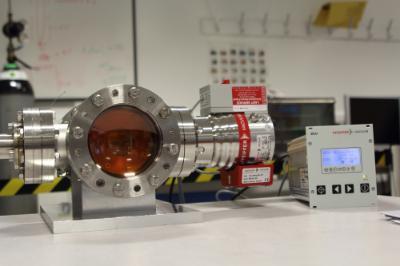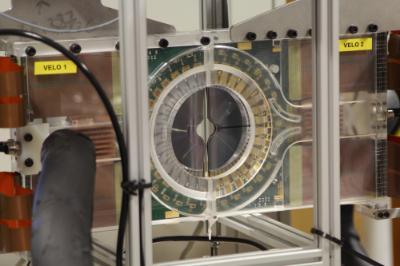Online Beam Monitor Based on the LHCb VELO Detector
Online beam monitoring in medical accelerators is essential in assuring patient’s safety as well as high quality and efficacy of cancer treatment. Charged particle beams deposit the highest energy transfer at the end of their path in the patient’s tissue. Hence, beam energy and energy spread; position and lateral profile of the beam as well as the beam current have to be precisely determined and recorded. In clinical practice ionisation chambers provide users with information on the delivered dose and beam profile. ICs however are interceptive devices degrading both the beam profile and its fine energy spread. Hence a new non – interceptive method of online beam monitoring is being investigated in the QUASAR Group.

The LHCb VELO detector is a position sensitive silicon detector, which has been used for tracking vertices originating from collisions at the LHCb experiment at CERN. Its advantageous semi-circular design enables approaching the core of the beam, however, without interfering with it. Thus, it allows precise measurements of the beam ‘halo’ around it. The QUASAR Group is investigating the possible stand-alone operation of the detector as an online current monitor through obtaining treatment beam ‘halo’ maps at the Clatterbridge Cancer Centre (CCC). The readout of the VELO detector is synchronized with the 60 MeV proton beam delivered at the frequency of 25.7MHz. Cross-correlation of the halo maps with the absolute current measurement provided by a locally-build Faraday Cup are the assumption for the non – invasive monitoring of the beam. Further optimisations of the low noise electronics and the design of the Faraday Cup are investigated to match the beam properties and resolve beam with bunch to bunch accuracy. Also, implementation of the VELO detector in further cutting-edge medical hadron centres is envisaged.
Additionally, the project is linked with the extensive works on the beam transport are carried out to characterise the emittance at the end of the line for precise numerical studies of the ‘halo’ propagation and predicting the ‘halo’ signal to beam current ratio within the OMA project.

Even though, the technology of the LHCb VELO detector is rather expensive, the results may lead to optimisation of the detector specifically to match the parameters of medical hadron machines and its permanent implementation for Quality Assurance purposes or as a standalone online detector.
Currently involved QUASARs:
Hao, Roland, Jacinta, Narender, Carsten
Selected publications:
T. Cybulski, C.P. Welsch, 'A Non-Invasive Beam Monitor for Hadron Therapy Beams', IBIC 2013, Oxford, UK (2013)
T. Cybulski, O. Karamyshev, C.P. Welsch, A. Degiovanni, 'Beam Emittance Measurements and Beam Transport Optimization at the Clatterbridge Cancer Centre', Proc. IPAC13, Shanghai, China (2013)
T. Cybulski, C. P. Welsch, T. Jones, 'Non-invasive beam diagnostics for a 60 MeV proton beam', Proc. BIW, Virginia, USA (2012)
C.P. Welsch, R. Boll, T. Cybulski, S. Sellner, S. Tegami, M.H. Holzscheiter, 'Development of Imaging Techniques for Medical Accelerators within the QUASAR Group', Proc. PAC, New York City, USA